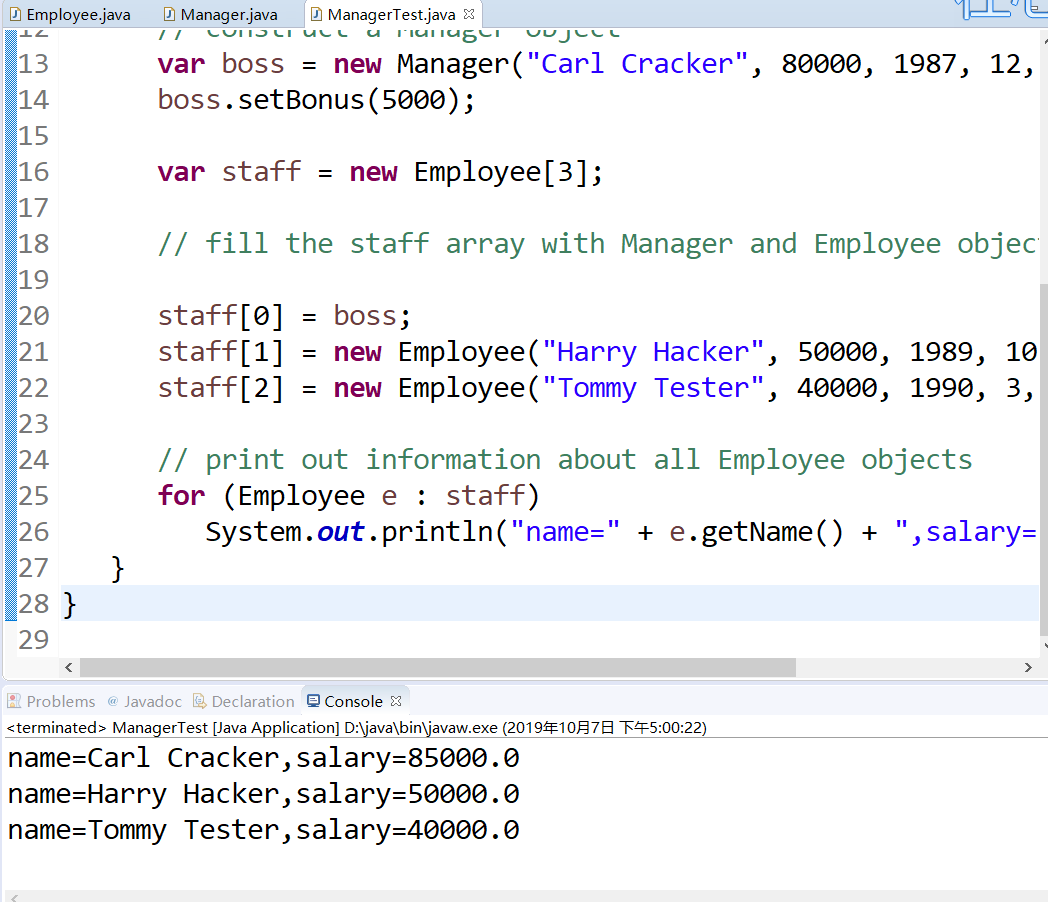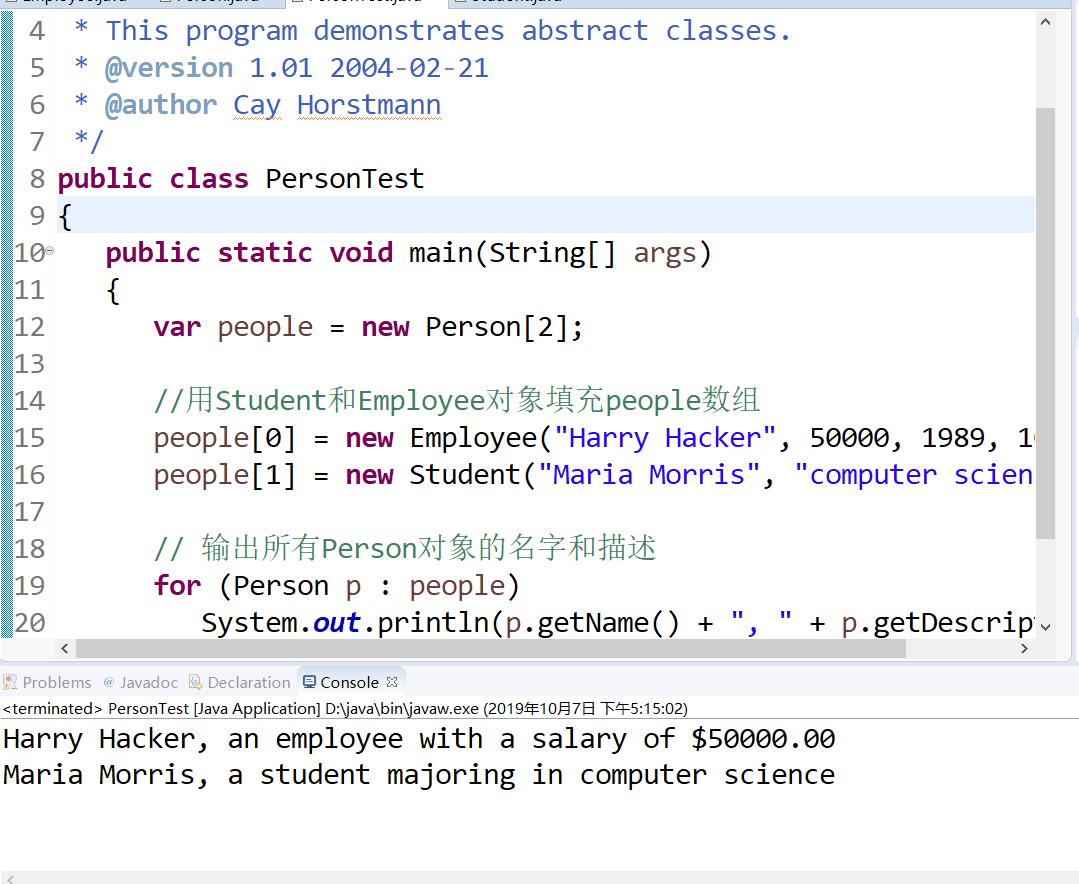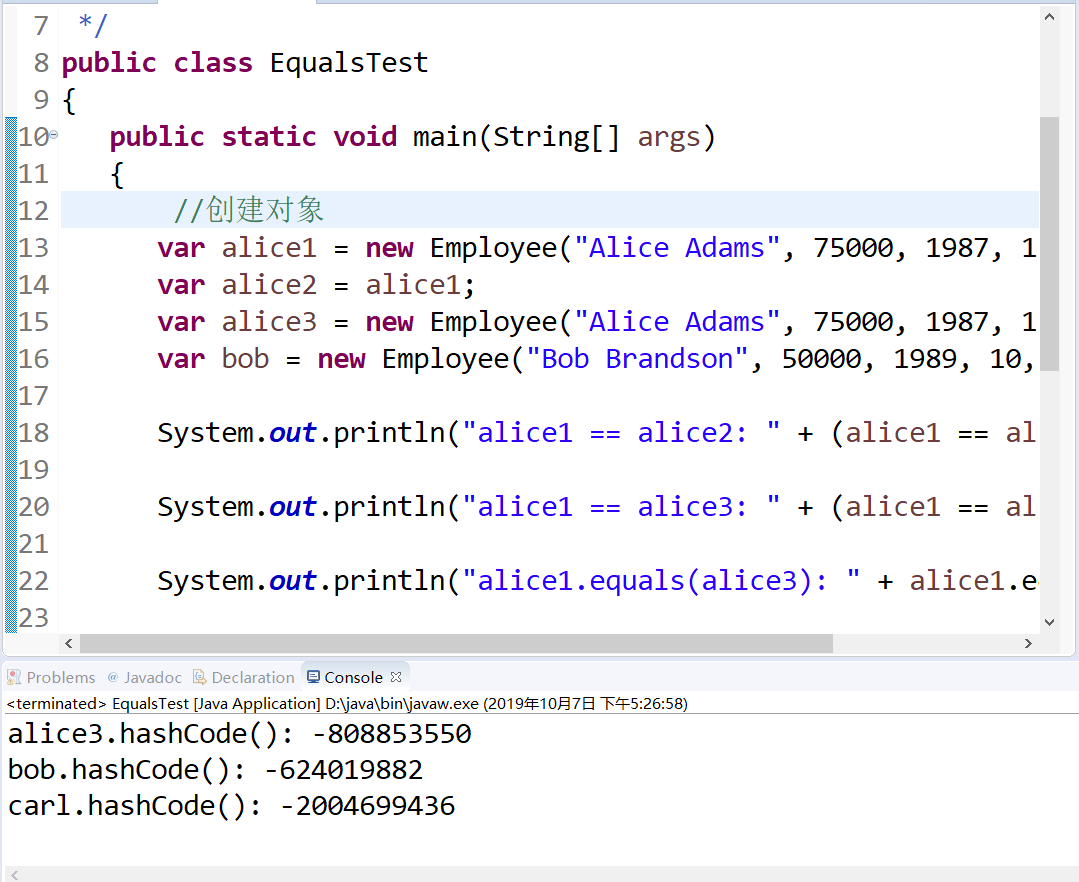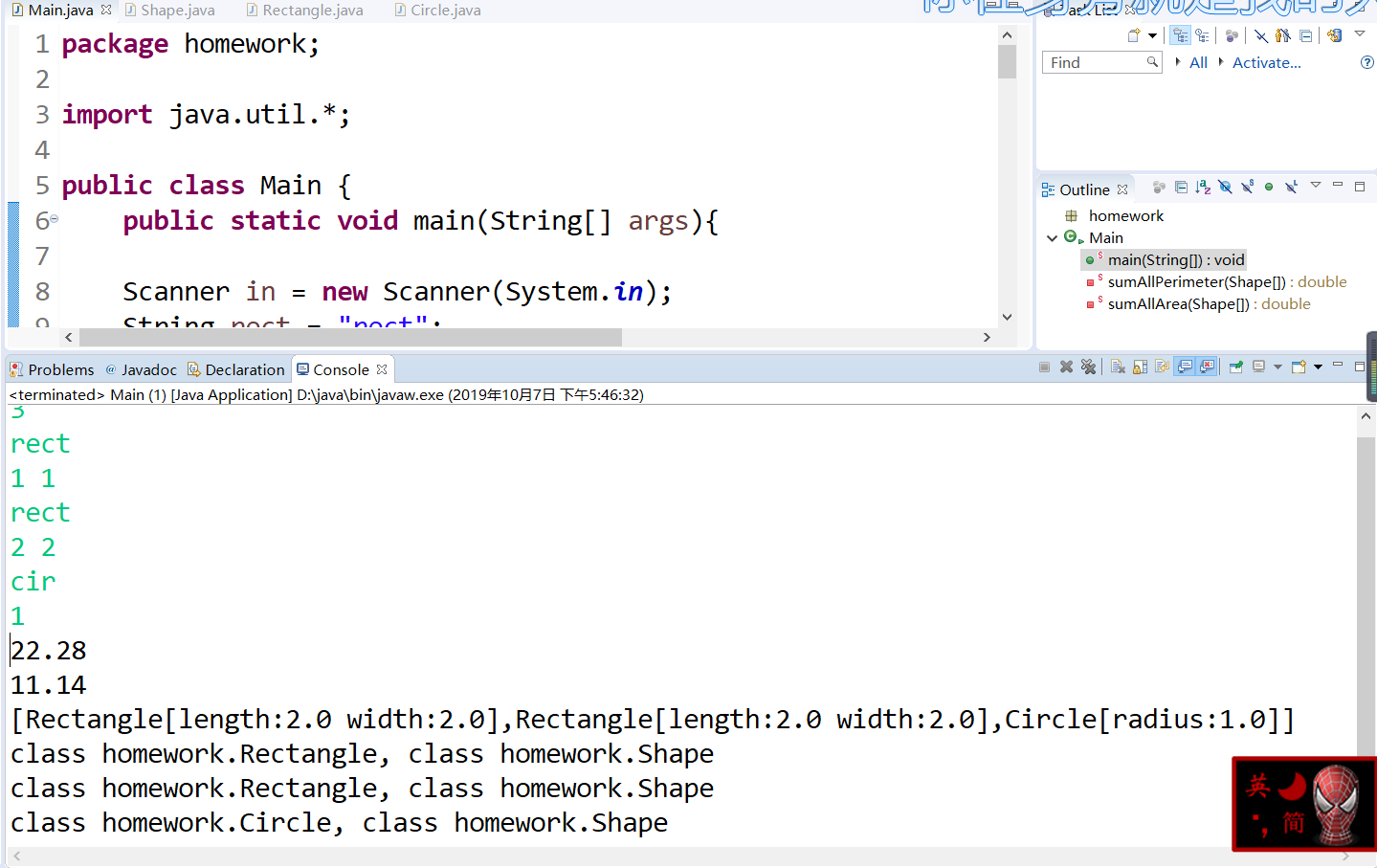博文正文开头:(2分)
|
项目 |
内容 |
|
这个作业属于哪个课程 |
https://www.cnblogs.com/nwnu-daizh/ |
|
这个作业的要求在哪里 |
https://www.cnblogs.com/nwnu-daizh/p/11605051.html |
|
作业学习目标 |
|
第一部分:总结第五章理论知识(30分)
一、类,超类和子类
1>继承:用已有类来构建新类的一种机制。当定义了一个新类继承了一个类时,一个新类就继承了这个类的方法和域,同时在新类中添加新的方法和域以适应新环境;
类继承的格式:class 新类名 extends 已有类名
2>多态性的概念:多态性泛指在程序中同一个符号在不同情况下具有不同解释的现象;
3>抽象类的定义:
abstract class Person
{
public abstract String getDescription();
...... ↓
} abstract 方法:只能声明,不能实现;
二、Object:所有类的超类
Object 类是Java中所有类的祖先——每一个类都由它扩展而来。在不给出超累的情况下,Java会自动把Object作为要定义的超类。
三、泛型数组列表
ArrayList是一个采用类型参数的泛型类。为指定数组列表保存元素的对象类型,需要用一对尖括号将数组元素的对象类名括起来加在后面;
ArrayList的定义:ArrayList<T> 对象 = new ArrayList<T>();
相当于一个容器。
四、对象包装器与自动装箱
所有基本数据类型都有与之对应的预定义类,它们被称为对象包装器。
五、参数数量可变的方法
用户自己可以定义可变参数的方法,并将参数指定为任意类型,甚至是基本类型;
六、枚举类
声明枚举类:public enum Grade{A、B、C、D、E},它包括一个关键字enum,一个新枚举类型的名字Grade定义的一组值,这里的值既不是整型,也不是字符型;
七、反射
反制机制可以用来:
1>在运行时分析类的能力;
2>在运行时查看对象
3>实现通用的数组代码能力
4>利用Method对象
八、继承的设计技巧
1>将公共操作和域放在超类;
2>不要使用受保护的域;
3>除非所有继承的方法都有意义,否则就不要使用继承;
4>在覆盖方法时,不要改变预期的行为;
第二部分:实验部分
1、实验目的与要求
(1) 理解继承的定义;
(2) 掌握子类的定义要求
(3) 掌握多态性的概念及用法;
(4) 掌握抽象类的定义及用途。
2、实验内容和步骤
实验1:测试程序1(10分)
1> 在elipse IDE中编辑、调试、运行程序5-1 —5-3(教材152页-153页) ;
2> 掌握子类的定义及用法;
3> 结合程序运行结果,理解并总结OO风格程序构造特点,理解Employee和Manager类的关系子类的用途,并在代码中添加注释;
4>删除程序中Manager类、ManagerTest类,背录删除类的程序代码,在代码录入中理解父类与子类的关系和使用特点。
代码如下
ManageTest类
/** * This program demonstrates inheritance. * @version 1.21 2004-02-21 * @author Cay Horstmann */ public class ManagerTest { public static void main(String[] args) { // 创建一个 Manager 对象 var boss = new Manager("Carl Cracker", 80000, 1987, 12, 15); boss.setBonus(5000); var staff = new Employee[3]; //用Manager and Employee 对象填充staff数组 staff[0] = boss; staff[1] = new Employee("Harry Hacker", 50000, 1989, 10, 1); staff[2] = new Employee("Tommy Tester", 40000, 1990, 3, 15); //输出所有关于Employee 对象的信息 for (Employee e : staff) System.out.println("name=" + e.getName() + ",salary=" + e.getSalary()); } }
Employee类
import java.time.*; public class Employee { private String name; private double salary; private LocalDate hireDay; //写构造函数 public Employee(String name, double salary, int year, int month, int day) { this.name = name; this.salary = salary; hireDay = LocalDate.of(year, month, day); } //写父类中的各种方法 public String getName() { return name; } public double getSalary() { return salary; } public LocalDate getHireDay() { return hireDay; } public void raiseSalary(double byPercent) { double raise = salary * byPercent / 100; salary += raise; } }
Manage类
public class Manager extends Employee { private double bonus; /** * @param name the employee's name * @param salary the salary * @param year the hire year * @param month the hire month * @param day the hire day */ public Manager(String name, double salary, int year, int month, int day) { super(name, salary, year, month, day); bonus = 0; //子类中多了一个成员变量 } public double getSalary() { double baseSalary = super.getSalary(); return baseSalary + bonus; //重写父类中的getSalary方法 } public void setBonus(double b) { bonus = b; } }
运行结果如下:

实验1:测试程序2(10分)
1>编辑、编译、调试运行教材PersonTest程序(教材163页-165页);
2>掌握超类的定义及其使用要求;
3>掌握利用超类扩展子类的要求;
4>在程序中相关代码处添加新知识的注释;
5>删除程序中Person类、PersonTest类,背录删除类的程序代码,在代码录入中理解抽象类与子类的关系和使用特点。
Employee类
import java.time.*; public class Employee extends Person { //继承父类并重写方法 private double salary; private LocalDate hireDay; public Employee(String name, double salary, int year, int month, int day) { super(name); this.salary = salary; hireDay = LocalDate.of(year, month, day); } public double getSalary() { return salary; } public LocalDate getHireDay() { return hireDay; } public String getDescription() { return String.format("an employee with a salary of $%.2f", salary); } public void raiseSalary(double byPercent) { double raise = salary * byPercent / 100; salary += raise; } }
Person类
public abstract class Person //抽象类 { public abstract String getDescription(); private String name; public Person(String name) { this.name = name; } public String getName() { return name; } }
Student类
public class Student extends Person { private String major; /** * @param name the student's name * @param major the student's major */ public Student(String name, String major) { //传递姓名给父类的管理者 super(name); this.major = major; } public String getDescription() { return "a student majoring in " + major; } }
PersonTest类
/** * This program demonstrates abstract classes. * @version 1.01 2004-02-21 * @author Cay Horstmann */ public class PersonTest { public static void main(String[] args) { var people = new Person[2]; //用Student和Employee对象填充people数组 people[0] = new Employee("Harry Hacker", 50000, 1989, 10, 1); people[1] = new Student("Maria Morris", "computer science"); // 输出所有Person对象的名字和描述 for (Person p : people) System.out.println(p.getName() + ", " + p.getDescription()); } }
运行结果如下:

实验1:测试程序3(11分)
1>编辑、编译、调试运行教材程序5-8、5-9、5-10,结合程序运行结果理解程序(教材174页-177页);
2>Object类的定义及用法;
3>在程序中相关代码处添加新知识的注释。
Employee类
import java.time.*; import java.util.Objects; public class Employee { private String name; private double salary; private LocalDate hireDay; public Employee(String name, double salary, int year, int month, int day) { this.name = name; this.salary = salary; hireDay = LocalDate.of(year, month, day); } public String getName() { return name; } public double getSalary() { return salary; } public LocalDate getHireDay() { return hireDay; } public void raiseSalary(double byPercent) { double raise = salary * byPercent / 100; salary += raise; } public boolean equals(Object otherObject) { // 查看对象是否相同的快速测试 if (this == otherObject) return true; // 如果显式参数为空,则必须返回false if (otherObject == null) return false; // 如果类不匹配,就不能相等 if (getClass() != otherObject.getClass()) return false; // 现在我们知道otherobject是一个非空雇员 var other = (Employee) otherObject; // 测试字段是否具有相同的值 return Objects.equals(name, other.name) && salary == other.salary && Objects.equals(hireDay, other.hireDay); } public int hashCode() { return Objects.hash(name, salary, hireDay); } public String toString() { return getClass().getName() + "[name=" + name + ",salary=" + salary + ",hireDay=" + hireDay + "]"; } }
Manage类
public class Manager extends Employee { private double bonus; public Manager(String name, double salary, int year, int month, int day) { super(name, salary, year, month, day); bonus = 0; } public double getSalary() { double baseSalary = super.getSalary(); return baseSalary + bonus; } public void setBonus(double bonus) { this.bonus = bonus; } public boolean equals(Object otherObject) { if (!super.equals(otherObject)) return false; var other = (Manager) otherObject; // super.equals检查这个和其他的是否属于同一个类 return bonus == other.bonus; } public int hashCode() { return java.util.Objects.hash(super.hashCode(), bonus); } public String toString() { return super.toString() + "[bonus=" + bonus + "]"; } }
EqualTest类
/** * This program demonstrates the equals method. * @version 1.12 2012-01-26 * @author Cay Horstmann */ public class EqualsTest { public static void main(String[] args) { //创建对象 var alice1 = new Employee("Alice Adams", 75000, 1987, 12, 15); var alice2 = alice1; var alice3 = new Employee("Alice Adams", 75000, 1987, 12, 15); var bob = new Employee("Bob Brandson", 50000, 1989, 10, 1); System.out.println("alice1 == alice2: " + (alice1 == alice2)); System.out.println("alice1 == alice3: " + (alice1 == alice3)); System.out.println("alice1.equals(alice3): " + alice1.equals(alice3)); System.out.println("alice1.equals(bob): " + alice1.equals(bob)); System.out.println("bob.toString(): " + bob); var carl = new Manager("Carl Cracker", 80000, 1987, 12, 15); var boss = new Manager("Carl Cracker", 80000, 1987, 12, 15); boss.setBonus(5000); System.out.println("boss.toString(): " + boss); System.out.println("carl.equals(boss): " + carl.equals(boss)); System.out.println("alice1.hashCode(): " + alice1.hashCode()); System.out.println("alice3.hashCode(): " + alice3.hashCode()); System.out.println("bob.hashCode(): " + bob.hashCode()); System.out.println("carl.hashCode(): " + carl.hashCode()); } }
运行结果如下:

实验2:编程练习(20分)
• 定义抽象类Shape:
属性:不可变常量double PI,值为3.14;
方法:public double getPerimeter();public double getArea())。
• 让Rectangle与Circle继承自Shape类。
• 编写double sumAllArea方法输出形状数组中的面积和和double sumAllPerimeter方法输出形状数组中的周长和。
• main方法中
1)输入整型值n,然后建立n个不同的形状。如果输入rect,则再输入长和宽。如果输入cir,则再输入半径。
2) 然后输出所有的形状的周长之和,面积之和。并将所有的形状信息以样例的格式输出。
3) 最后输出每个形状的类型与父类型,使用类似shape.getClass()(获得类型),shape.getClass().getSuperclass()(获得父类型);
思考sumAllArea和sumAllPerimeter方法放在哪个类中更合适?
输入样例:
3
rect
1 1
rect
2 2
cir
1
输出样例:
18.28
8.14
[Rectangle [width=1, length=1], Rectangle [width=2, length=2], Circle [radius=1]]
class Rectangle,class Shape
class Rectangle,class Shape
class Circle,class Shape
代码如下:
Shape类
public abstract class Shape { final double PI =3.14; public abstract double getPerimeter(); public abstract double getArea(); public abstract double getName(); }
Rectangle类
public class Rectangle extends Shape{ static double width; static double length; public Rectangle(double w,double l){ width = w; length = l; } public double getPerimeter(){ double Perimeter = (width+length)*2; return Perimeter; } public double getArea(){ double Area = width*length; return Area; } public String toString(){ return getClass().getName() + "[ width=" + width + "]"+ "[length=" + length + "]"; } public double getN(){ double a=1; return a; } public double getName() { return 0; } }
Circle类
public class Circle extends Shape { static double radius; public Circle(double r){ radius = r; } public double getPerimeter(){ double Perimeter = 2*PI*radius; return Perimeter; } public double getArea(){ double Area = PI*radius*radius; return Area; } public String toString(){ return getClass().getName() + "[radius=" + radius + "]"; } public double getName(){ return 0; } }
Main类
import java.util.*; public class Main { public static void main(String[] args){ Scanner in = new Scanner(System.in); String rect = "rect"; String cir = "cir"; int n; n= in.nextInt(); double[] c = new double[n]; Shape[] shapes= new Shape[n]; for(int i=0;i<n;i++) { String in2 = in.next(); if(in2.equals(rect)) { double length = in.nextDouble(); double width = in.nextDouble(); shapes[i] = new Rectangle(width,length); c[i]=1; } if(in2.equals(cir)) { double radius = in.nextDouble(); shapes[i] = new Circle(radius); c[i]=2; } } System.out.println(sumAllPerimeter(shapes)); System.out.println(sumAllArea(shapes)); System.out.printf("["); for(int i=0;i<n;i++) { if(c[i]==1) System.out.printf("Rectangle["+"length:"+Rectangle.length+" "+Rectangle.width+"]"); else System.out.printf("Circle["+"radius:"+Circle.radius+"]"); if(n!=1&&i<n-1) System.out.printf(","); } System.out.println("]"); for(Shape s:shapes) { System.out.println(s.getClass()+", "+s.getClass().getSuperclass()); } in.close(); } private static double sumAllPerimeter(Shape shape2[]) { double sum = 0; for(int i = 0;i<shape2.length;i++) sum+= shape2[i].getPerimeter(); return sum; } private static double sumAllArea(Shape shape1[]) { double sum = 0; for(int i = 0;i<shape1.length;i++) sum+=shape1[i].getArea(); return sum; } }
运行结果如下:

3. 实验总结:(10分)
通过本章知识的学习,我了解的类之间的继承关系,Object类,泛型数组列表,参数数量可变的方法,枚举类,以及反射等相关内容,在运行程序的过程中,加深了对它的理解。在自主完成作业的时候,我查了很多的资料,对他们的理解更近了一步。虽然终于中犯过很多的错误,甚至遇到过很多无从下手的题目,但最终都成功地解决了,并且完成了本次实验报告。通过这次实验,我意识到自己还有很多的不足之处,在今后的学习生活中,我会更加努力,不断进步。